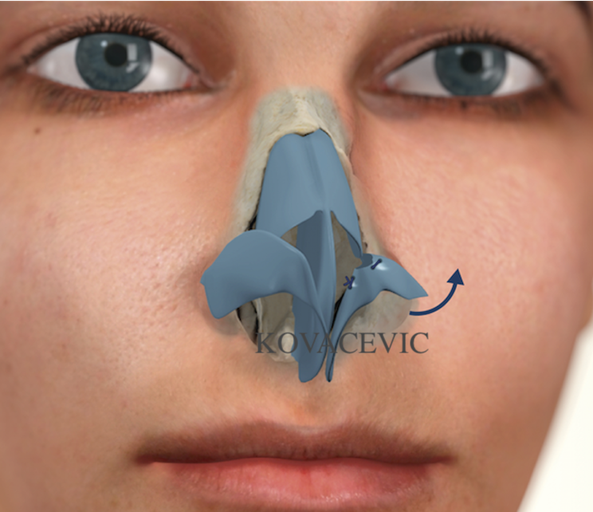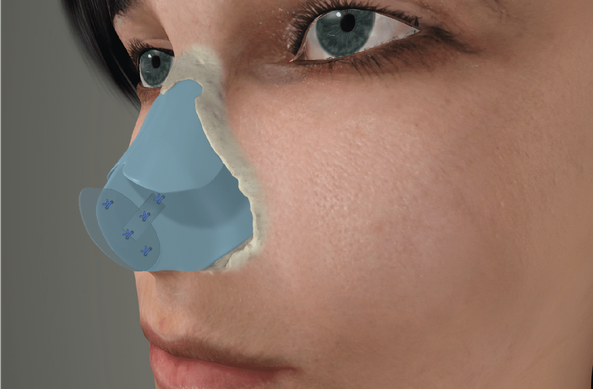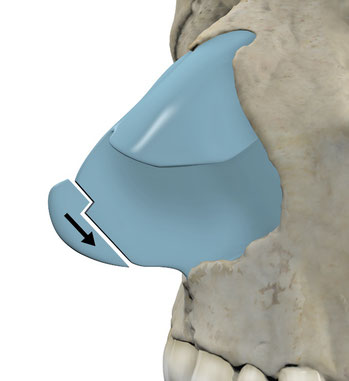Nose tip correction in Hamburg

The nose tip is one of the most dominant and distinctive structures on our face.
Comprehensive analysis of the anatomical conditions and precise planning adjusted to them are the prerequisites to ensure a successful correction procedure with the use of the latest surgical techniques.
In some cases it is not necessary to operate tje entire nose, n order to achieve an aesthetically beautiful nose, the sole operation of the nose tip is sufficient:
The shape of the nose can vary in numerous ways: The nose may have a very broad tip - commonly known as a "bulbous nose" - or the tip may display a pronounced cleft. It may appear to be very crooked and asymmetrical or be perceived as very pointed or drooping.
We will be pleased to advise you in this respect in our Hamburg practice for nasal surgery.
The broad nose tip as a common cause
It is particularly important in the case of broad nasal tips to first evaluate the approximate skin thickness. Narrowing down to the desired size is only possible if the skin is not too thick. However, if the patient fails to clearly understand this fact, disappointment can easily arise after the surgery as the expectations remain unfulfilled.
The skin is composed of three separate layers that are connected to each other in various degrees. Apart from a fine layer of fat as the lowest layer, there is the dermis (middle skin layer) and the outer skin, also called the epidermis.
Surgically, the only thing that can be done is a careful thinning of the fat layer. Nevertheless, this does not solve all the problems of thick skin.
A more radical manipulation can end up with unsightly scars on the tip of the nose that are very difficult to treat afterwards. In the case of a normal skin coat, refinement of the nose tip is achieved by modelling of the underlying cartilage - if possible without removing larger amounts of cartilage.
The nose tip is principally shaped by means of a fine suture which, when put together, gives the nose tip the appearance of a diamond or rhombus - with the broad base at the highest point of the nose tip. This also stabilizes the nostrils at the same time. This suture (cranial tip suture) was developed in our practice and has demonstrated very good results so far. It is used by many colleagues worldwide.
In the case of pre-operated noses, it is quite common that an essential part of the nasal tip structure is missing. Stabilization with fine, cartilaginous grafts is required in these cases to obtain the desired shape.

Surgery on the nose tip usually takes about 45 minutes to 1 hour, and the final result can be seen much more quickly than in the case of surgery performed on the entire nose.
Drooping nose tip
A drooping nose tip can also have a very unflattering aesthetic effect on the face. It usually makes the face appear older and rougher, the nose longer.
The elevation of the nose tip is achieved by means of small cartilage grafts. Inherently, the tip of our nose is only held together by fine connective tissue filaments. As we get older, the tension decreases and the tip of the nose drops gradually. The desired effect can be achieved permanently by stabilizing the nose tip by means of cartilage, which fastens it to the nasal septum. The required cartilage is obtained from the nasal septum itself.
Artificial or foreign cartilage is not used.
Will my tip drop later on?
The picture presents the so-called septal extension graft after overlapping and stabilization with the "embracement graft".
The most decisive aspect of nasal tip modeling is the persistence of the result. The nose tip has to retain the achieved result even after a long period of time. The surgical techniques available for this purpose have changed considerably in recent years. In the past, the surgery on the nose tip was often followed by gradual drooping. Therefore, surgeons used to over-rotate the nose tip in order to compensate for this future change. This often led to the so-called piggy nose. Nowadays we know that stabilization of the nose tip is fundamental for a long-lasting shape.
Surprisingly, despite better knowledge, there are still some surgeon colleagues who ignore or misinterpret basic anatomical facts - especially the thickness and thus the weight of the skin at the nose tip. Tightness of the tissues declines in all people over the course of their lives. The older a person gets, the more drooping the nose tip becomes, and the longer it appears for many. An agile nose tip with a natural droop will almost always lower over the years.
Our concept is based on the principle of strengthening the nasal structure at the nose tip. In this procedure, a cartilaginous graft is removed from the nasal septum and integrated into the tip of the nose. In this way, the position of the nose tip can be determined from the very beginning and the necessary stability can be achieved. This concept has proved to be successful for more than 20 years. The nose tip remains in the desired position. The sensation of stiffening of the tip partially disappears after several years and it becomes normal - like the rigid nasal bridge. In the exceptional cases where the cartilage in the nasal bridge area is naturally very stable, only a very small stabilization graft can be used. The resulting mobility is enhanced.
The following two pictures demonstrate the principle of the so-called Stair Step Extension Graft. This does not allow the nose tip to drop.
Sources:
-M. Kovacevic et al. Neue Aspekte in der Nasenspitzenchirurgie, HNO ,12/2015
-M. Kovacevic et al. Cranial Tip Suture in Nasal Tip Contouring, Facial Plastic Surgery 2014;30:681-687
-M. Kovacevic, Kapitel „Dorsal Refinement“ aus dem Buch „ Dorsal Preservation“







